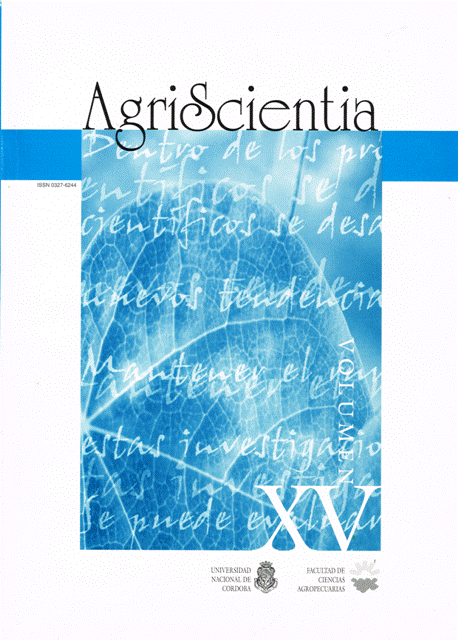Physiological quality of peanut (Arachis hypogaea L.) seeds with different degrees of maturity
Main Article Content
Abstract
The objective of this article was to establish, for peanut crop production in Córdoba (Argentina), the incidence of fruit maturity on seed physiological quality, with the purpose of determining the best maturity percentage for peanut harvest when the finality is seed production. Fruits obtained under different water conditions were classified by maturity. Maturity profiles and seed dry weight in each maturity class were determined. The seeds of each maturity class were utilized in standard germination, seedling dry weight, and accelerated ageing tests. Irrigation treatment significantly increased the fruit maturity proportion. There was no incidence of maturity on seed standard germination but a slight effect on germination following accelerated ageing. The seedling dry weight, without its cotyledons, was significantly affected by seed maturity.
Article Details

This work is licensed under a Creative Commons Attribution-ShareAlike 4.0 International License.
How to Cite
References
Boote, K.J., 1982. Growth stages of peanut (Arachis hypogaea L.). Peanut Science, 9: 35-40.
Downes, R.W., 1985. Factors affecting germination of sunflowers under low temperature conditions. Actas XI Conferencia Internacional de Girasol, Mar del Plata, pp. 87-92.
Edge, O.T. and J.S. Burris, 1970. En: Handbook of Vigour Test Methods. International Seed Testing Association, 1995, Ed. por J.G. Hampton y D.M. TeKrony, Zurich, Suiza, p. 22.
Giambastiani, G., 1996. Características físicas de los frutos de maní durante la maduración. III Jornada Nacional del Maní, 26 de septiembre de 1996, General Cabrera, Córdoba, pp. 8-10.
Giambastiani, G., 1998. Calidad fisiológica de las semillas de maní obtenidas con diferente disponibilidad hídrica en el suelo. Tesis de postgrado, Universidad Nacional de Córdoba.
Golombek, S.D., R. Sridhar y U. Singh, 1995. Effect of soil temperature on the seed composition of three Spanish cultivars of Groundnut (Arachis hypogaea L.). Journal of Agricultural and Food Chemistry, 43: 2067-2070.
Instituto Nacional de Semillas y Plantas de Vivero, 1978. Manual para evaluación de plántulas en análisis de germinación. Madrid, España, pp. 89-90.
Iribarren, C.A., 1986. Determinación de la calidad de cereales y oleaginosos. 2ª edición. Ed. por la Cooperadora Amigos de la Escuela de Recibidores de Granos, p. 359.
Ketring, D.L., 1991. Physiology of Oil Seeds: IX. Effects of water deficit on peanut seed quality. Crop Science, 31: 459-463.
Pedelini, R. y R. Díaz, 1991. Efecto del tamaño de la semilla sobre el comportamiento del maní tipo runner. Revista Agropecuaria de Manfredi, VII(1): 27-29.
Pedelini, R., 1997. Determinación del momento de arrancado. Manual del Maní. Ed. por R. Pedelini y C. Casini. 2ª edición, pp. 30-31.
Sanders, T.H., P.D. Blankenship, R.J. Cole y J.S. Smith, 1986. Role of agrometeorological factors in postharvest quality of groundnut. Proceedings of an International Symposium, 21-26 Aug. 1985, ICRISAT, India, pp. 185-192.
Spears, J.F. y G.A. Sullivan, 1995. Relationship of hull mesocarp color to seed germination and vigor in large-seeded Virginia-type peanuts. Peanut Science, 22: 22-26.
Villagra, A., 1988. Informe sobre la problemática de la calidad de la semilla. Panorama Manisero, 4: 10-13.
Williams, E.J. y J.S. Drexler, 1981. A non-destructive method for determining peanut pod maturity. Peanut Science, 8: 134-141.





